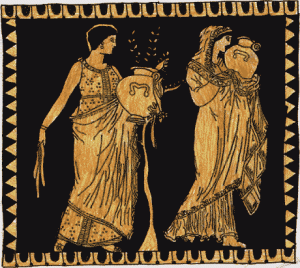 Today, veiling is a globally polarizing issue, and a locus for the struggle between contemporary and traditional interpretations of Islam. But veiling was a practice long before Islam. Veiling— of women, of men, and of sacred places and objects—has existed in countless cultures and religions. This article introduces to the use and symbolism of the veil in ancient Middle Eastern or Western Asian cultures.
Today, veiling is a globally polarizing issue, and a locus for the struggle between contemporary and traditional interpretations of Islam. But veiling was a practice long before Islam. Veiling— of women, of men, and of sacred places and objects—has existed in countless cultures and religions. This article introduces to the use and symbolism of the veil in ancient Middle Eastern or Western Asian cultures.
The first known use of the veil dates back to the Assyrians, the rulers of Mesopotamia (present-day Iraq, with an Empire stretching from the Persian Gulf to the Mediterranean Sea) from about 1380 to 612 BCE. Assyrian law dictated that wives, daughters, and widows must wear a veil, but prostitutes and slave women were forbidden from it. The veil thus served as a way of protecting a father or husband’s interest in his daughter or wife. The alluring face of a married or marriageable woman could not tempt men from beneath a veil. Wives, daughters, and widows would be severely punished for not covering their faces in public. But punishments also extended to male observers. If a man recognized a prostitute or slave woman wearing a veil and did not report her to an authority, he could be publicly flogged (beaten), mutilated (having his hand chopped off, for example), or imprisoned. The veil was a sign of the delineation between elite and common women.
From the 5th century BCE in Persia, royal women of the Achaemenid Empire were veiled and riding in curtained carriages. In Pahlavi legal texts, wearing a hair covering such as a snood is mentioned as being a custom of Zoroastrian women. Later in classical Persian texts such as the Shahnameh (ca. 1000 C.E.), women are mentioned often as wearing head coverings. The head coverings (chador in Persian) were also mentioned as being worn by kings as well. Common people did not wear veils of any kind but often covered their mouths with their fingers when in front of a monarch, apparently not to offend the monarch with their breath. This practice continues for male Zoroastrian priests to this day, protecting the sacred fire from the pollution of their breath. In modern times in Iran, Zoroastrian women are seen to wear a loose-fitting garment (chador) over the head and body, but the face and some of the hair is allowed to be seen.
In Ancient Greece between 900 BCE and 200 CE, women’s clothing concealed the body, and women’s veils came in a variety of forms to conceal the head to varying degrees. One of the most common veils was the kredemnon, which is built from the noun “head” (karê) and the verb “to bind” (deô) and literally means “head-binder”. This word was also used to denote city battlements and bottle stoppers, which are vessels “whose contents are sealed against dirt and loss”. As such, the kredemnon both safeguards women’s chastity and protects men from the debilitating “dangers and pollution” of female sexuality. Women’s bodies, associated with and polluted by the transitional events of birth and death, made them suitable agents for preparing corpses for burial, for representing the disorder of death on their bodies via mourning gestures, and for kneeling in submission to the gods to make their prayers on behalf of their families more powerful and effective. The polluting power of women’s bodies meant that they had to be tightly controlled, bounded both sartorially and spatially. Ideally contained within the domestic sphere and veiled when they emerged into the public sphere, women’s liminality allowed them special prominence in ritual even as it justified their marginal status “as only partial members of the human community”.
However, according to many scholars, Greek women wore head-coverings at times, and there is no good reason to think that they were under some compulsion to cover their heads in public. Also, the idea that immoral women were recognized as such by the absence of veils has no basis at all. Depictions found on pottery show women with their hair done up in a knot and wearing a band of cloth wrapped around the head to keep the hair in place, and sometimes there is no hair-band. In ancient illustrations and sculptures that do show Greek women with covered heads, the head-covering is usually just the ‘himation’ pulled over the head and wrapped around the neck without covering the face. A woman might wear a scarf tied closely around her hair called a ‘kaluptra’, but she is depicted nude, and the covering seems only ornamental. Regarding religious practices, there are clear indications that it was the custom for women to take part to rituals with their heads uncovered – such as the cult of the goddess Demeter, or in the worship of Dionysus where the female celebrants known as ‘maenads’ not only came with uncovered heads but also let down their hair and danced in public processions. Priestesses most probably used to present offerings without head-coverings.
As for Ancient Arabian Peninsula, most nomadic men and women, because they were exposed to all kinds of severe weather conditions, used to often cover their heads and wear long garments. Covering the heads was neither a religious nor social obligation. Veiling apparently existed among some classes, particularly in the towns, though it was probably more prevalent in the countries that the Arabs had contact with.
To be continued…
